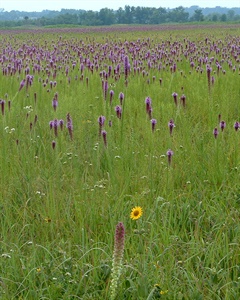Historical records indicate that there were as many as 2 million acres of naturally open grassland habitat in Arkansas in the early 1800s. These open habitats have been generically referred to as “prairies” in the past. Many were true tallgrass prairies, but others would be more appropriately classified as glades or barrens.
Tallgrass prairies often have rich topsoil and, as the name implies, are dominated by several species of tall grasses, most notably big bluestem (Andropogon gerardii), little bluestem (Schizachyrium scoparium), switchgrass (Panicum virgatum), and Indiangrass (Sorghastrum nutans). In addition to these “backbone species”, prairies support hundreds of other species of grasses, sedges, rushes, forbs (wildflowers), and shrubs as well as a rich and varied fauna.
In the Great Plains and Upper Midwest, tallgrass prairies dominated the landscape because rainfall amounts are low enough that drought-tolerant prairie grasses and wildflowers have an advantage over trees, which need more water. In Arkansas, we generally have enough rainfall to support forests so there are other factors responsible for the existence of our prairies. The two main ones are droughty soil conditions (often caused by the presence of a clay or rock layer in the soil near the surface of the ground) that limit the amount of moisture available to plants and the tendency for these areas to burn about once every 2 to 3 years.
In contrast to prairies, glades typically have much thinner soils and occur where bedrock outcrops or comes very close to the surface of the ground. These are basically rocky “microdeserts” and are home to true desert plants such as false aloe (Manfreda virginica), rock pink (Phemeranthus calycinus), Arkansas yucca (Yucca arkansana), and eastern pricklypear cactus (Opuntia humifusa). These habitats generally include a grassland element dominated by shorter annual grasses such as dropseed (Sporobolus spp.) and three-awn grasses (Aristida spp.). Drought-tolerant perennials such as little bluestem and sideoats grama (Bouteloua curtipendula) may occur in areas of thicker soils around rock outcrops. Glades are known for their high number of rare and endemic species.
In addition to glades, blackland praire and sandhill barrens are the more likely place we will be working with the Arkansas Game and Fish Commission (AGFC) to remove cedar. The sandhill barrens community occurs on the higher portion of the rolling hills in southwest Arkansas on deep, excessively well-drained sands. This is an open, thinly wooded community characterized by drought-adapted, fire-tolerant herbaceous vegetation with considerable patches of bare sand between plants in some areas. Dominant species include several species of three-awn grass (Aristida spp.), little bluestem (Schizachyrium scoparium), splitbeard bluestem (Andropogon ternarius), slender Indiangrass (Sorghastrum elliottii), and many species of forbs (some very rare).
